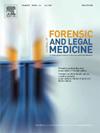Life-threatening spontaneous splenic rupture in congenital afibrinogenemia: Two case reports and systematic literature review
IF 1.2
4区 医学
Q3 MEDICINE, LEGAL
引用次数: 0
Abstract
Background
Spontaneous splenic rupture is a rare life-threatening finding with a challenging diagnosis which is largely ignored in the literature. Hematological disorders such as afibrinogenemia are reported to cause bleeding disorders mostly cerebral hemorrhage. Despite being a life-threatening condition, data about spontaneous splenic rupture in patients with Afibrinogenemia remain scarce. Such fatal incidents should warrant diligent efforts to establish and adopt prevention measures in this particularly vulnerable population.
We report two new cases of spontaneous splenic rupture in two siblings, diagnosed with congenital afibrinogenemia since early childhood. In addition, we report the results of a systematic review of the literature of cases that have reported the occurrence of splenic rupture in afibrinogenemia, with the aim of filling the gap in the clinical course of such an uncommon event.
Methods
We conduced a systematic review of English and French language publications cataloged in Pubmed, and Google Scholar up to December 2022. We opted to include articles written in other languages if an English language abstract was available and contained the information needed for our report. The following MeSH (medical subject heading) search criteria were used: ''splenic rupture'' AND ''afibrinogenemia.'' The above search strategy was further combined with a supplementary strategy that included the MeSH terms ''spleen'', AND ''rupture'' AND ''Afibrinogenemia''. In order to reduce the selection bias in searching on the Google Scholar database, we searched for articles containing these MeSH terms in their titles.
Results
We reported two cases of splenic rupture in two family members who were diagnosed with afibrinogenemia at the age of 1 year. The splenic rupture was misdiagnosed by clinicians in the brother's case, resulting in his death and presenting as a forensic case. However, the sister underwent a splenectomy one week before her brother's death following the onset of asthenia and acute abdominal pain.
Then we conducted a literature review of relevant studies of spontaneous splenic rupture in Afibrinogenemia. A selection of 13 relevant studies was included in the final review, describing a total of 25 cases of spontaneous splenic rupture in Afibrinogenemia. One paper was an international cross-sectional study across 25 different countries involving 211 patients with fibrinogen disorders, showing that 11 patients with afibrinogenemia had developed spontaneous splenic rupture. The remaining 12 articles were case reports or case series, describing a total of 14 cases of atraumatic splenic rupture in afibrinogenemia, ranging from 0 to 28 years old, with a median age of 14.5 years, where the majority were infants (age inferior to 18) with the most cases occurred in the age group of 10–15 years old.
Conclusion
Congenital afibrinogenemia is a rare disease with a wide range of clinical symptoms and with challenging management. While the most common presenting symptoms are bleeding and thrombosis, spontaneous spleen rupture is rare and probably underdiagnosed which consequently may lead to death. Studies about the topic remain scarce, hence, further studies are needed to ascertain this risk and establish target preventive measures for this vulnerable population.
先天性纤维蛋白原血症致危及生命的自发性脾破裂2例报告及系统文献复习。
背景:自发性脾破裂是一种罕见的危及生命的发现,具有挑战性的诊断在很大程度上被文献所忽视。据报道,血液学疾病如纤原蛋白血症可引起出血性疾病,主要是脑出血。尽管是一种危及生命的疾病,关于纤原蛋白血症患者自发性脾破裂的资料仍然很少。这种致命事件应使我们在这一特别脆弱的人口中努力制定和采取预防措施。我们报告两个新的自发性脾破裂的两个兄弟姐妹,诊断为先天性纤原蛋白血症自儿童早期。此外,我们报告了一项系统的文献综述的结果,这些文献报道了在纤维蛋白原血症中发生脾破裂的病例,目的是填补这种罕见事件的临床过程中的空白。方法:我们对截至2022年12月Pubmed和谷歌Scholar收录的英文和法文出版物进行了系统综述。如果有英文摘要,并且包含我们报告所需的信息,我们选择纳入用其他语言写的文章。使用以下MeSH(医学主题标题)搜索标准:“脾破裂”和“纤原蛋白血症”。上述搜索策略与一个补充策略进一步结合,该策略包括MeSH术语“脾脏”、“破裂”和“纤原性贫血”。为了减少在谷歌Scholar数据库中搜索时的选择偏差,我们搜索了标题中包含这些MeSH术语的文章。结果:我们报告了两例脾破裂的两个家庭成员谁被诊断为纤维蛋白原血症在1岁。在该兄弟的病例中,临床医生误诊脾脏破裂,导致他死亡,并作为法医病例出现。然而,在她哥哥死前一周,因出现虚弱和急性腹痛,妹妹接受了脾切除术。然后我们对纤原蛋白血症自发性脾破裂的相关研究进行了文献综述。在最后的回顾中,我们选择了13项相关的研究,共描述了25例纤原蛋白血症自发性脾破裂。一篇论文是一项国际横断面研究,涉及25个不同国家的211例纤维蛋白原紊乱患者,显示11例纤维蛋白原血症患者发生自发性脾破裂。其余12篇文章为病例报告或病例系列,共报道了14例纤维蛋白原血症的非外伤性脾破裂病例,年龄从0岁到28岁,中位年龄14.5岁,其中大多数为婴儿(18岁以下),大多数病例发生在10-15岁年龄组。结论:先天性纤维蛋白原血症是一种罕见的疾病,临床症状广泛,治疗困难。虽然最常见的症状是出血和血栓形成,但自发性脾破裂是罕见的,可能未被诊断,因此可能导致死亡。关于这一主题的研究仍然很少,因此,需要进一步的研究来确定这一风险,并为这一弱势群体制定目标预防措施。
本文章由计算机程序翻译,如有差异,请以英文原文为准。
求助全文
约1分钟内获得全文
求助全文
来源期刊

Journal of forensic and legal medicine
MEDICINE, LEGAL-
CiteScore
2.70
自引率
6.70%
发文量
106
审稿时长
57 days
期刊介绍:
The Journal of Forensic and Legal Medicine publishes topical articles on aspects of forensic and legal medicine. Specifically the Journal supports research that explores the medical principles of care and forensic assessment of individuals, whether adult or child, in contact with the judicial system. It is a fully peer-review hybrid journal with a broad international perspective.
The Journal accepts submissions of original research, review articles, and pertinent case studies, editorials, and commentaries in relevant areas of Forensic and Legal Medicine, Context of Practice, and Education and Training.
The Journal adheres to strict publication ethical guidelines, and actively supports a culture of inclusive and representative publication.
 求助内容:
求助内容: 应助结果提醒方式:
应助结果提醒方式:


